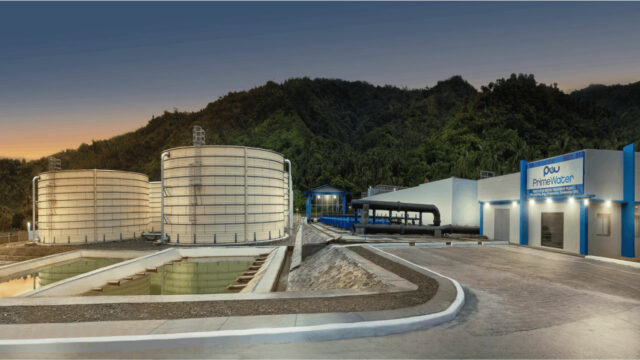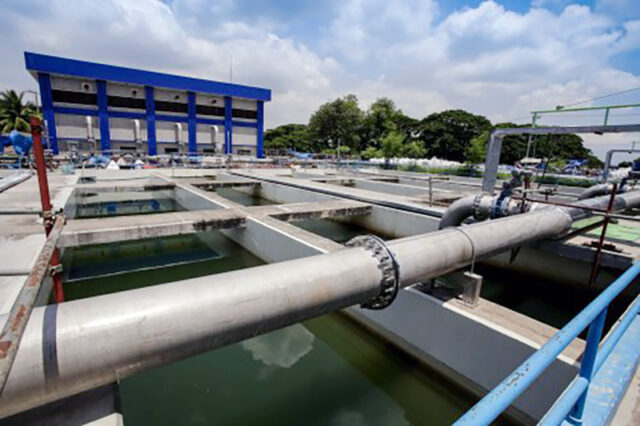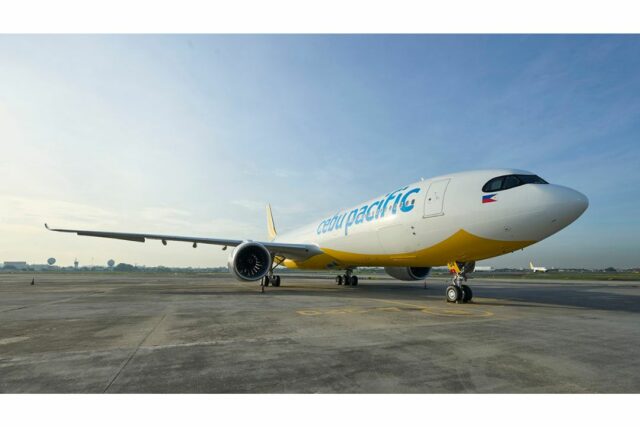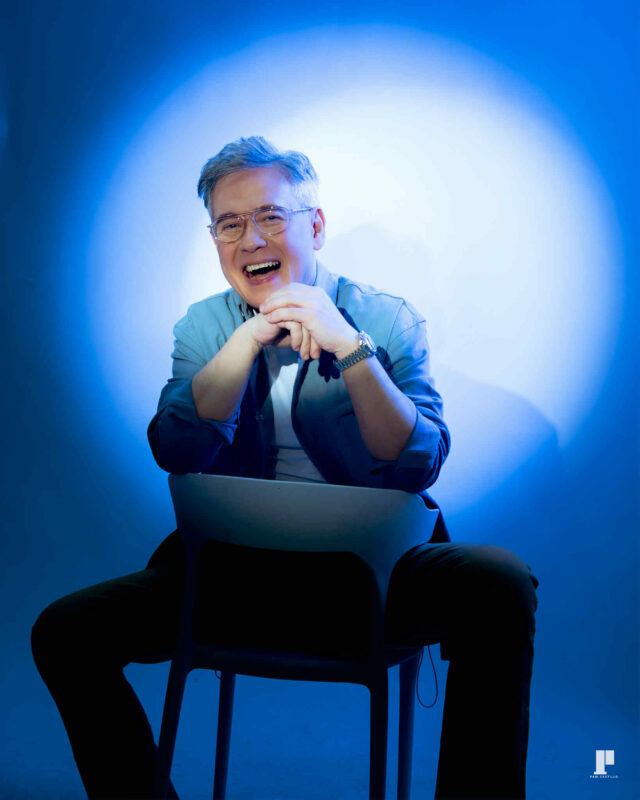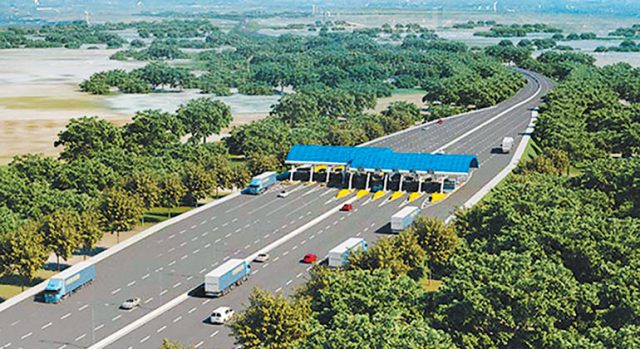Mouthwash may cure ‘the clap’
PARIS — In the 19th century, before the advent of antibiotics, Listerine mouthwash was marketed as a cure for gonorrhoea. More than 100 years later, researchers said Tuesday the claim may be true.
Marcos vows to ramp up spending
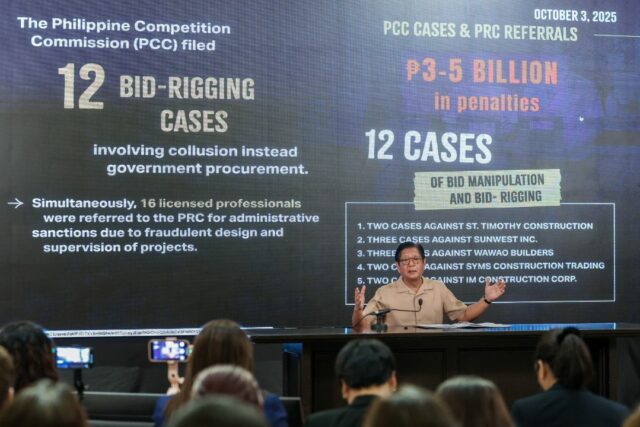
PHILIPPINE President Ferdinand R. Marcos, Jr. on Thursday pledged to ramp up government spending in the fourth quarter, as a corruption scandal contributed to weaker-than-expected growth in the third quarter.
“We have implemented many measures because public spending will now be increased to make sure that by the end of the year, the spending levels are aligned with our original plan — so we can recover what was lost in the third quarter,” Mr. Marcos said in mixed English and Filipino during a press briefing in Malacañang.
The Department of Budget and Management (DBM) earlier said it has programmed P1.31 trillion for disbursement during the October-to-December period to boost economic growth.
In the third quarter, the Philippine gross domestic product (GDP) growth slowed to a four-year low of 4% from the 5.5% expansion in the second quarter and 5.2% a year ago.
The sharp economic slowdown was mainly attributed to the corruption mess that dampened government spending and affected consumer and investor confidence.
For the first nine months of the year, GDP growth averaged 5%, slower than 5.9% in the same period last year, and below the government’s 5.5-6.5% full-year target.
The government is probing a multibillion-peso corruption scandal involving public works projects, where government officials allegedly colluded with private contractors to inflate costs and approve ghost infrastructure. It has affected investor confidence in the Philippines, weighing on the stock market and the Philippine peso.
Mr. Marcos vowed to put the culprits behind bars before Christmastime.
“They won’t have a Merry Christmas. Before Christmas, they will be jailed,” he said.
Mr. Marcos said the slowdown in economic activity in the third quarter can be partly blamed on the string of typhoons.
“There really was a downturn in economic activity. You have to remember that it’s not only because of these problems. Because of the typhoons, we lost working days in the economy,” he said.
Mr. Marcos also attributed the slower growth to the trade uncertainties, which are also affecting the global economy.
“We are not the only ones suffering the shocks that come from the new trade structure that has been imposed on the rest of the world. And so, we are all adjusting to that,” he added.
Since Aug. 7, the US has imposed a 19% duty on many goods from the Philippines, Cambodia, Malaysia, Thailand and Indonesia.
DBCC TO REVIEW TARGETS
Meanwhile, the Development Budget Coordination Committee (DBCC) is set to review its macroeconomic assumptions and targets next week, Senate Committee on Finance Chairman Sherwin T. Gatchalian said.
During the plenary debates for the 2026 national budget, Mr. Gatchalian said he is certain there will be revision in the growth targets.
“Next week the DBCC will once again meet and talk about this, possibly a revision in terms of our 2025 economic growth, and also the succeeding years 2025-2028,” Mr. Gatchalian said.
This was in response to Senator Risa N. Hontiveros-Baraquel’s question if the weak third-quarter growth will prompt a revision of the DBCC targets.
“We will also have a slightly lower economic growth forecast for the end of the year, about… 4.7-5%, Mr. President. And then our debt to GDP will still be at 63%,” Mr. Gatchalian said.
In June, the DBCC tempered its growth forecast to 5.5-6.5% for 2025 and 6-7% for 2026, mainly due to “heightened global uncertainties” arising from the Middle East conflict and US tariffs.
Mr. Gatchalian said there are a lot of factors that have affected the growth outlook, such as the series of typhoons and recent earthquakes.
Last week, Economy Secretary Arsenio M. Balisacan warned that hitting the low end of the 5.5-6.5% growth target would be “very challenging,” with more storms expected this quarter.
For next year, Mr. Gatchalian flagged external headwinds such as US trade policies that will have a negative impact on growth.
At the same time, Mr. Gatchalian said restoring public trust requires accountability, stressing that those involved in the flood control corruption scandal must face charges and be jailed before yearend.
“That’s why all of this flood control issue is giving us a lot of headache in terms of outgrowing debt. But still, that’s why the administration is really bent on holding people to account by putting them to jail, and that will bring back confidence and in turn revive our economic growth in the next quarter,” he said.
Filomeno S. Sta. Ana III, coordinator of Action for Economic Reforms, said the slowdown in economic growth is also due to the government’s lack of a “coherent” growth strategy.
“The main reason why our GDP growth is below target is that the current administration does not have a coherent growth strategy, and worse has allowed or enabled policies and activities that undermine growth (diversion of pub-lic funds to Maharlika, revenue-eroding measures, transfer of PDIC (Philippine Deposit Insurance Corp.) and PhilHealth (Philippine Health Insurance Corp.) funds to National Government, ‘most corrupt budget,’ massive corruption, etc,” he said in a Viber message. — Chloe Mari A. Hufana and Aubrey Rose A. Inosante
Approved investment pledges plunge 49% in Q3

APPROVED foreign investment pledges plunged nearly 50% in the third quarter as investor sentiment soured due to the corruption scandal involving government infrastructure projects, the local statistics agency said.
Preliminary data from the Philippine Statistics Authority (PSA) showed the value of foreign commitments approved by investment promotion agencies (IPAs) fell by 48.7% to P73.68 billion in the July-to-September period from P143.74 billion in same period last year.
However, this was the highest amount of investment pledges since the third quarter of 2024.
Ser Percival K. Peña-Reyes, director of the Ateneo Center for Economic Research and Development, said the decline in approved investments can be attributed to the weaker investor sentiment.
“Tingin ko. Wala pang nakukulong eh (I think so. No one has been imprisoned yet),” he said in a Viber message, when asked if this sharp slump in approved investments will likely persist in the fourth quarter until 2026.
Quarter on quarter, the approved pledges rose by 9.34% from P67.38 billion in the second quarter.
Singapore was the top source of foreign investment pledges in the third quarter with P20.26 billion (27.5%), followed by Japan with P13.59 billion (18.4%) and Cayman Islands with P13.14 billion (17.8%).
Investment commitments from South Korea stood at P5.57 billion (7.6%), while those from China stood at P4.51 billion (6.1%)
PSA data showed the investment pledges were approved by seven IPAs — the Authority of the Freeport Area of Bataan, Bases Conversion and Development Authority (BCDA), Board of Investments (BoI), Clark Development Corp., Clark International Airport Corp., Philippine Economic Zone Authority (PEZA), and Subic Bay Metropolitan Authority.
The PEZA approved foreign investment pledges worth P47.29 billion, accounting for the bulk or 64.2% of the total in the third quarter.
Meanwhile, BoI approved P20.22 billion worth of pledges (27.4% share), followed by BCDA with P5.1 billion (6.9% share).
In the July-to-September period, the Bangsamoro Board of Investments, Cagayan Economic Zone Authority, John Hay Management Corp., the Poro Point Management Corp., Tourism Infrastructure and Enterprise Zone Authority, and Zamboanga City Special Economic Zone Authority did not approve any investment pledges.
In addition, the PSA said about 49% or P36.12 billion of the approved foreign investments will go to the manufacturing industry, while 24.4% or P17.98 billion will be invested in the electricity, gas, steam and air-conditioning supply sector.
The real estate sector cornered P11.86 billion or about 16.1% of the total pledges.
By region, Calabarzon received P28.23 billion or 38.3% of investment pledges, followed by Central Luzon with P16.42 billion (22.3% share) and Bicol Region with P13.03 billion (17.7% share).
Meanwhile, the PSA said investment pledges from both foreign and Filipino nationals in the third quarter fell by 36.1% to P343.77 billion from the P538.36 billion a year earlier.
Of the total, Filipino nationals contributed P270.1 billion or 78.6% of investment pledges.
This brought total approved investments to P343.77 billion, down 36.1% year on year.
If these materialize, around 27,605 jobs are expected to be created from these investments.
The PSA data on foreign investment commitments, which may materialize in the near future, differ from actual foreign direct investments tracked by the Bangko Sentral ng Pilipinas for the balance of payments. The central bank’s monitoring goes beyond the projects and includes other items such as reinvested earnings and lending to Philippine units via their debt instruments. — Aubrey Rose A. Inosante
Finance Usec. Mendoza takes over BIR

By Chloe Mari A. Hufana, Reporter
PRESIDENT Ferdinand R. Marcos, Jr. has appointed Finance Undersecretary Charlito Martin R. Mendoza as the new commissioner of the Bureau of Internal Revenue (BIR), replacing Romeo D. Lumagui, Jr., as the agency struggles to meet its 2025 revenue collection target.
In a Viber chat to reporters on Wednesday evening, acting Press Secretary Dave M. Gomez confirmed the change within the agency but did not elaborate further.
Mr. Mendoza took his oath of office before Mr. Marcos at Malacañan Palace on Thursday morning.
Finance Secretary Ralph G. Recto on Thursday expressed confidence the BIR will exceed its revenue targets under Mr. Mendoza, who was undersecretary of the Department of Finance (DoF).
“I trust that under (Mendoza’s) leadership, the BIR will meet and even exceed our revenue targets. Above all, I trust that he will always keep the well-being of our taxpayers at the heart of all your efforts,” Mr. Recto said in a statement on Thursday.
Mr. Recto called the new BIR chief a “steady hand and reform-driven leader,” citing his prior roles as Finance undersecretary since April 2024.
As undersecretary, Mr. Mendoza headed the Finance department’s Revenue Operations Group, working closely with the BIR and the Bureau of Customs (BoC).
He previously served as district collector of the BoC Port of Cebu from July 2019 to October 2022. Under his leadership, the port achieved record-breaking revenue collections and notable milestones in border protection, according to an April 2024 statement from the DoF.
He also steered the Port of Cebu to become the first Customs collection district in the country to have its main port and all subports ISO 9001:2015 certified.
Prior to joining the government, Mr. Mendoza built a legal career as a founding partner of the Palafox Patriarca Romero and Mendoza Law Firm.
He previously worked as an associate lawyer at the Angara Abello Concepcion Regala and Cruz Law Offices and the Suarez and Narvasa Law Firm.
Mr. Mendoza placed third in the 2004 Philippine Bar Examinations after earning his Bachelor of Laws degree from San Beda University. He also holds a degree in Geodetic Engineering from the University of the Philippines and is a licensed Geodetic Engineer.
The new BIR chief’s appointment comes as Mr. Lumagui earlier this week said the agency may fall short of its P3.219-trillion collection target for 2025.
“The overall performance is low… so there’s a need to recalibrate or recalculate the entire goal,” Mr. Lumagui told BusinessWorld in an interview in mixed English and Filipino on Nov. 11. “As things stand, it’s going to be quite difficult.”
The latest Treasury data showed that BIR collections jumped by 10.88% to P2.32 trillion in the first nine months of the year. However, this was 2.63% lower than the programmed P2.38 trillion for the January-to-September period.
The BIR, the main revenue collection agency, needs to collect around P897 billion to reach the P3.219-trillion full-year program.
Mr. Lumagui was a BIR deputy commissioner when the President’s term started in 2022, but was promoted as BIR chief in November 2022.
Mr. Recto said Mr. Lumagui was a “great partner” and a “fearless leader” that made a stronger and more credible BIR.
Rizal Commercial Banking Corp. Chief Economist Michael L. Ricafort said the leadership change highlighted the need for the government to boost tax collections to fund its budget deficit and key programs that promote inclusive growth and poverty reduction.
“This is also part of the fiscal reform measures to further improve overall fiscal and debt management over the long-term and for the coming generations,” Mr. Ricafort said. — with Aubrey Rose A. Inosante
SEIPI urges gov’t to help sector as it loses competitiveness
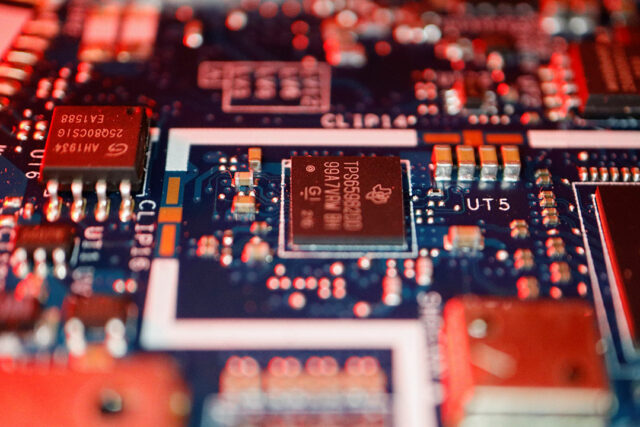
By Justine Irish D. Tabile, Reporter
THE Semiconductor and Electronics Industries in the Philippines Foundation, Inc. (SEIPI) is seeking government support for the sector as it loses its competitiveness amid new US trade deals with Southeast Asian neighbors.
SEIPI President Danilo C. Lachica said the Philippines lost its edge when the US reciprocal tariff rates on other electronics exporter-countries were lowered.
“What you’re up against is the power cost, the logistics cost, the water cost, and the aggressiveness of the government,” he told BusinessWorld on the sidelines of the PASIAWORLD 2025 Annual Supply Chain Conference on Thursday.
“Our edge was the reciprocal tariff. But now, it’s a level playing field in terms of the tariff,” he added.
In August, the US began imposing a 19% tariff on most goods from the Philippines, Malaysia and Thailand, while a 20% tariff is charged on Vietnam.
Asked if the final agreements between the US and other members of the Association of Southeast Asian Nations (ASEAN) could further impact the competitiveness of the country, he said that it will remain “business as usual” until new rates are announced for the Philippines.
“Well, what we tell our (SEIPI) members for now is to take that as gospel truth. For now, that’s our reciprocal tariff. If that changes because of the US Supreme Court decision that challenges its legality, or Trump announces a new tariff, then we respond,” he said.
“You can’t afford to have analysis paralysis, and you will not do anything. So, just do your normal business,” he added.
For now, semiconductors and some electronics manufacturing services products are exempt from the reciprocal tariff.
“Am I secure with our 0% tariff for now? Yes, but I’m not going to hold my breath. Like I said, it just depends on how the wind blows in Washington, DC, but we’ll see,” he said.
“I think by the first or second quarter we should have some resolution there, and hopefully it’s favorable for the Philippines,” he added.
However, he said that there is a need for the Philippines to find new markets for its exports amid the US reciprocal tariff.
“We really need to look at new markets… whether it is ASEAN, African, or European. Especially in Europe, not many have heard of the capabilities of the Philippines,” he said.
“The interesting thing is, Latin American countries like Panama are inquiring, and Canada is also inquiring, so we really have to diversify our markets,” he added.
Mr. Lachica said that the Philippines must already establish its own wafer fabrication facility to remain competitive.
“If we don’t do this, we are probably just going to compete with Timor-Leste or Laos, while our more advanced neighbors are still going to grow their semiconductor and electronics industry,” he said.
Despite the challenges faced by the sector, he said recent trade numbers show the possibility that the exports of semiconductors and electronics will have modest growth.
“It’s becoming clearer that we will exceed flat growth. You would be pleasantly surprised. It is doing better than we expected,” he said. “What is driving it is artificial intelligence and the internet of things, so it is really advanced technology.”
In the first nine months, the country exported $33.52 billion worth of electronic products, up 9.5% from $30.6 billion a year prior.
Meanwhile, Mr. Lachica said that the corruption scandal has been sending a bad signal to multinational companies.
“As you know, multinationals don’t tolerate that kind of problem. If ever there’s anything uncovered, they fire the executive,” he said.
In particular, Mr. Lachica said some companies are seeking assurance from local partners on how they can be shielded from the effects of corruption.
“There is interest. Continuous? I hope. Significant? I hope. But there are also major concerns,” he added.
Mr. Lachica said businesses want to see the results of the Independent Commission for Infrastructure’s (ICI) probe on the alleged graft and corruption in government projects.
“The problem is, the ICI investigation has been going on for months, but no one is convicted. The credibility and sense of urgency, I don’t see it. I hope we get some conviction soon because it sends a bad message,” he said.
MPIC, Villar group in initial talks for PrimeWater deal
HONG KONG — Metro Pacific Investments Corp. (MPIC) has started evaluating the potential acquisition of Villar-led PrimeWater Infrastructure Corp., as it reviews the company’s operations and financials.
“We signed the NDA (non-disclosure agreement) with them. They have opened up the data room to us. We are getting initial feedback from the preliminary analysis on the numbers they have provided us,” MPIC Chairman, President, and Chief Executive Officer Manuel V. Pangilinan said during the company’s briefing in Hong Kong on Thursday.
Mr. Pangilinan said the company is still conducting first-stage analysis and will likely need another week to frame an offer.
“Nothing is finalized yet. We are at the beginning of the process,” he added.
MPIC is taking a cautious approach, considering how to structure a potential acquisition, he noted. “I think they have about 70 to 80 properties all over the Philippines, and some are small, some are big. We do not know the approach yet, whether we will bid for only certain of the properties that are large enough to give us profitability, or whether they will insist that we acquire the entire thing.”
MPIC already has a significant presence in the water sector through Metro Pacific Water (MPW), its water infrastructure investment arm, and Maynilad Water Services, Inc., which serves the West Zone of Metro Manila under a government concession.
PrimeWater, a subsidiary of Prime Asset Ventures, Inc., serves over 1.7 million households and supplies about 500 million liters of water per day across more than 100 partnered water districts nationwide. Its operations span multiple provinces, including Bulacan, Batangas, and Laguna. The company is owned by Manuel Paolo A. Villar, the eldest of the Villar siblings.
On PrimeWater’s debt level, Mr. Pangilinan said no valuations have been discussed yet. “We haven’t discussed how to deal with those debts, so no valuations have been indicated by us to them. We are looking, and I think if it works for us, if it’s commercially feasible, then obviously we will take a look at it more seriously,” he said.
Sought for comment, China Bank Capital Corp. Managing Director Juan Paolo E. Colet said the acquisition could turn out to be a profitable water services business for MPIC. “Depending on the final numbers and terms… just like what they did for Maynilad, they could turn this into a successful investment,” he said.
President Ferdinand R. Marcos, Jr. earlier directed the Local Water Utilities Administration, which supervises more than 500 water districts nationwide, to investigate consumer complaints against PrimeWater. The probe covers the company’s 73 joint venture agreements with local water districts.
MPIC is one of the three key Philippine units of Hong Kong-based First Pacific Co. Ltd., along with Philex Mining Corp. and PLDT Inc. Hastings Holdings, Inc., a unit of PLDT Beneficial Trust Fund subsidiary Medi-aQuest Holdings, Inc., holds a majority stake in BusinessWorld through the Philippine Star Group, which it controls. — Ashley Erika O. Jose
ACEN Corp. plans over P80-billion capex for 2026
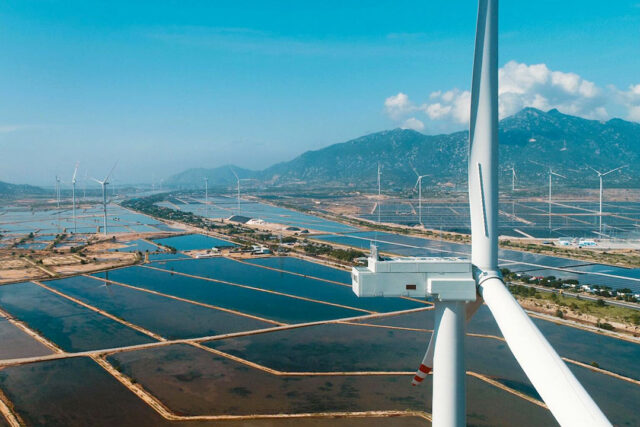
ACEN CORP., the listed energy platform of the Ayala group, plans to allocate more than P80 billion in capital expenditures (capex) next year to fund large-scale projects both in the Philippines and abroad, as the company continues its expansion in the renewable energy sector.
“Our best estimates at the moment is that next year will be north of P70 billion and could even be over P80 billion depending on the timing of projects,” Jonathan Back, ACEN’s group chief finance officer and chief strategy officer, said at the PSE STAR: Investor Day organized by the Philippine Stock Exchange on Thursday.
For the remainder of 2025, ACEN may spend over P50 billion, he added.
“As a company, we are largely focused on very large projects. But while these numbers sound very big and they are very big, most of the capex is funded through project finance,” Mr. Back said, noting that the company aims to cover asset funding primarily via project finance arrangements.
ACEN currently manages a renewable energy portfolio of 7.1 gigawatts (GW) across the Philippines, Australia, Vietnam, India, Indonesia, Laos, and the United States, with projects totaling 2,215 megawatts under construction as of Nov. 7.
While the company maintains an aspirational goal of expanding its portfolio to 20 GW by 2030, Mr. Back emphasized a cautious approach to growth.
“Given the amount of renewable capacity that needs to be built in all of the various markets that we operate in, by global standards, it’s not as big a number as you might think,” he said.
“But nevertheless, given the amount of time that it does take to get especially these large projects built, and given the desire for us not to have to keep coming to the equity market for funding, we’ve moderated that target,” he added.
ACEN’s consolidated net income for the first nine months of 2025 fell 78% to P1.8 billion, largely due to non-recurring items, while revenues dropped 18% to P23 billion, affected by lower spot market prices and reduced output in the Philippines and Australia.
Despite the subdued performance, ACEN President and Chief Executive Officer Eric T. Francia expressed confidence in the company’s forward momentum.
“We remain focused on scaling our renewables portfolio and accelerating investments in energy storage in particular, with a long-term strategy anchored on disciplined expansion, strong partnerships, and delivering sustainable value,” he said. — Sheldeen Joy Talavera
Villar Land sets final property fair value at P52.74B, down from P1.33T
VILLAR LAND Holdings Corp. has set the final audited fair value of its newly acquired properties at P52.74 billion, according to its 2024 annual report filed with the Securities and Exchange Commission (SEC), sharply lower than an earlier estimate of P1.33 trillion that drew regulatory scrutiny.
The valuation covers 366 hectares of prime land within Villar City, a 3,500-hectare master-planned development spanning Metro Manila and Cavite. Villar Land acquired the properties through its purchase of Althorp Land Holdings, Inc., Chalgrove Properties, Inc., and Los Valores Corp. for P5.2 billion on Sept. 30 last year.
In its filing on Thursday, the company said the properties were initially appraised using the income approach, yielding an estimated value of about P1.3 trillion. After discussions with its external auditor, Punongbayan & Araullo (P&A), Vil-lar Land adopted the market approach for its audited financial statements.
“Appraisal reports were obtained from SEC-accredited property appraisers to support the fair value measurement… The company agreed to use the valuation based on market approach,” the report said.
According to Note 28 of the audited financial statements, the fair value of investment properties was disclosed at P52.74 billion, while the properties were recorded at P8,759,321,390 cost, in compliance with Philippine Financial Reporting Standards (PFRS).
P&A identified the valuation as a key audit matter, citing “significant judgments and high estimation uncertainty” in determining fair values. The audit report noted that the market approach relies on subjective inputs such as comparable sale prices, bargaining allowances, location, topography, and amenities, making valuations highly sensitive to assumption changes.
The auditors said they performed extensive procedures, including reviewing appraisal reports, testing assumptions against market data, and engaging independent valuation specialists to validate the figures.
The adjustment follows a SEC show-cause order issued to E-Value Phils., the original appraiser, to explain its P1.33-trillion valuation. The regulator also imposed P12 million in fines on Villar Land and 11 of its officials in August for delayed submission of audited financial statements, citing violations of the Securities Regulation Code.
The company reported a net income of P1.423 billion for 2024, slightly higher than P1.416 billion for 2023, marking a 0.5% increase year on year. The improvement was driven by higher interment and chapel service revenues, which grew 23% and 43%, respectively, offsetting a 26% decline in real estate sales.
Total assets surged 28% to P35.75 billion from P27.98 billion in 2023, largely due to the Villar City land acquisition and reclassification of investment properties. Investment properties at cost jumped from P76 million to P8.76 billion, an increase of P8.68 billion or 11,462%, while fair value disclosure rose to P52.74 billion.
Equity declined slightly by 3% to P13.67 billion, while liabilities rose 59% to P22.08 billion, reflecting higher payables and related-party obligations linked to the acquisition.
EARLIER UNAUDITED DISCLOSURE
On March 31, Villar Land reported a net income of P999.72 billion for 2024, up from P1.46 billion the previous year, attributing the spike to fair value gains on investment properties that ballooned to P1.33 trillion from P59 million in 2023.
Revenue fell by 25% to P3.58 billion as real estate sales declined by 26% to P3.31 billion due to lower residential unit sales.
Villar Land, formerly Golden MV Holdings, Inc., changed its name in November 2024 following an amendment to its articles of incorporation. It is among the country’s largest developers of memorial parks under the Golden Haven brand and mass housing projects through Bria Homes.
At the local bourse on Thursday, shares of Villar Land were down by 29.97% or P688 to close at P1,608 apiece. — Beatriz Marie D. Cruz and Arjay L. Balinbin
Maynilad posts P3.9-B Q3 net income, up 16% on higher revenues
FOLLOWING its stock market debut, Maynilad Water Services, Inc. reported a 16% increase in third-quarter (Q3) net income to P3.9 billion, driven by higher revenues.
Revenues for the quarter rose 8.4% year on year to P9.30 billion, reflecting a tariff increase, according to the company’s financial report released on Thursday.
For the nine months ending September, net income rose 18% to P11.41 billion, driven by higher topline growth and a modest 2% increase in cash operating expenses, Maynilad said.
Total revenues improved 9.5% to P27.65 billion, primarily reflecting the 8% tariff adjustment implemented at the start of the year and an upward revision in the environmental charge.
“This was partly offset by a 1.1% decline in billed volume, following government restrictions on Philippine offshore gaming operators (POGO) and the transfer or closure of several large commercial accounts in the West Zone,” the company added.
As of end-September, Maynilad’s non-revenue water — water lost through leaks or illegal connections — dropped to 32.8% from 39.3% last year, due to intensified pipe replacement and leak-repair initiatives.
The utility continues to invest heavily in system upgrades and new water-treatment facilities under its 2023-2025 capital expenditure program, Maynilad said.
Key projects on the water-supply side include the 150-million-liter-per-day (MLD) Poblacion Water Treatment Plant in Muntinlupa and modular treatment plants in Cavite. Wastewater undertakings include the 20-MLD Tunasan and 46-MLD Cupang Water Reclamation Facilities in Muntinlupa, and the larger 205-MLD CAMANA and 180-MLD Manila North wastewater-treatment projects.
“We continue to meet our service commitments while investing in the infrastructure that will sustain long-term growth,” said Maynilad President and CEO Ramoncito S. Fernandez. “Our operational gains and disciplined execution show that our fundamentals remain sound, and that we are on track with our 2025 operational and financial objectives,” he added.
Maynilad raised P34.34 billion from its initial public offering, the second-largest in the Philippine Stock Exchange’s history, last week.
The company is an integrated primary provider of sustainable water and wastewater services for the West Zone, covering 11 cities in Metro Manila, three of which have partial coverage, as well as portions of Cavite province.
Metro Pacific Investments Corp., which holds a majority stake in Maynilad, is one of three Philippine units of Hong Kong-based First Pacific Co. Ltd., the others being Philex Mining Corp. and PLDT Inc.
Hastings Holdings, Inc., a unit of PLDT Beneficial Trust Fund subsidiary MediaQuest Holdings, Inc., has an interest in BusinessWorld through the Philippine Star Group, which it controls.
Maynilad shares shed 2.16% to close at P14.50. — Sheldeen Joy Talavera
JG Summit Q3 core profit climbs to P4.6 billion on airline, real estate gains
JG SUMMIT Holdings, Inc. posted a core net income of P4.6 billion for the third quarter (Q3), up from P2.1 billion a year earlier, supported by gains in its airline, real estate, and food businesses, as well as reduced losses from its idle petrochemical plant.
“We continue to exhibit a strong upward trajectory in our recurring core profits, driven by the performance of our listed strategic business units, as well as the curbed losses from our mothballed petrochemical plant,” JG Summit President and Chief Executive Officer Lance Y. Gokongwei said in a statement on Thursday.
Revenues declined by 6% year on year to P83.5 billion, due to the shutdown of its loss-making petrochemical business earlier this year, the company said. Without it, the topline would have improved by 6%.
The company has yet to release its full financial report as of press time.
For the first nine months of the year, the company’s reported core profit slipped 5% to P19.3 billion amid the absence of the P7.9-billion gain from the merger between the Bank of the Philippine Islands (BPI) and Robinsons Bank Corp. (RBC) booked last year.
JG Summit said that its total revenues ended flat at P277.5 billion.
Excluding the downward impact of the plant shutdown, revenues climbed by 10% on the back of strong demand for travel and leisure, improving residential segment, and sustained volume-driven growth of its food and beverage unit.
The real estate and hotels businesses led by RBC delivered a revenue of P124.6 billion, up 5%, driven by higher volumes and market share gains in its domestic Branded Consumer Food segment, coupled with improving scale of the URC International business.
The air transportation segment through Cebu Air, Inc. saw an improvement of 18% to P87.6 billion, propelled by higher passenger volumes, fares, and cargo volumes.
Meanwhile, after shutting down its plant, streamlining operations, and transferring debt, JG Summit Olefins Corp. (JGSOC) was able to reduce its monthly losses to P90-100 million.
JGSOC has reduced its losses to P90-100 million following its plant shutdown, organizational rationalization, and full debt transfer to the parent company.
“Presently, JGSOC continues plant preservation while pursuing opportunistic monetization of idled assets,” the parent firm said. “At the same time, there are ongoing engagements with various relevant organizations as it explores strategic options to optimize company value considering prevailing market conditions.”
JG Summit said its share in the net income of Manila Electric Co. rose by 9% to P9.5 billion, primarily driven by the expansion of its power generation business and steady contributions from its electricity distribution segment.
Equity income from Singapore Land Group Ltd. increased by 9% to P1.5 billion with higher contributions from property investments plus better occupancy and rates in its commercial properties.
PLDT Inc. paid dividends of P96 per share, down P1. BPI increased its dividend distribution by 5% to P2.08 per share.
Shares in the company declined by 1.41% to P21 each. — Sheldeen Joy Talavera
Ayala Corp. Q3 income nearly doubles to P22.91 billion
AYALA CORP. booked a 96.16% increase in its third-quarter (Q3) attributable net income to P22.91 billion, up from P11.68 billion a year earlier.
In a statement on Thursday, the listed conglomerate said core net income went up 4% year on year to P12.8 billion, fueled by stronger contributions from Bank of the Philippine Islands (BPI) and Ayala Land, Inc. (ALI), alongside support from the company’s portfolio businesses, including AC Health, Inc., AC Logistics, Inc., Integrated Microelectronics, Inc. (IMI), and iPeople, Inc.
“While gross domestic product growth has slowed somewhat, our core businesses remain steady, and our portfolio businesses continue to improve. Our recently announced initiatives in retail, Makro and Spinneys, signify continued confidence in the long-term growth trend of the Philippine economy,” Ayala Chief Executive Officer Cezar P. Consing said.
Ayala’s core net income, excluding one-time items, remained stable year on year at P36.6 billion.
For the first nine months, Ayala’s reported attributable net income rose by 36.22% to P46.27 billion, mainly due to one-time gains from revaluing AC Ventures, which holds Ayala’s direct stake in Mynt. A remeasurement gain was recorded, according to the company, due to Mitsubishi’s acquisition of a 50% stake in AC Ventures, which resulted in indirect ownership of Mynt.
ALI, BPI, Globe Telecom, Inc., and AC Energy (ACEN) reported mixed results in the January-to-September period, with BPI and ALI posting net income growth, while Globe and ACEN saw declines due to lower revenues and higher expenses.
BPI’s net income increased by 5% to P50.5 billion, driven by solid loan growth and an expanding net interest margin (NIM). Return on equity stood at 15%.
Ayala Land’s net income also rose 1% to P21.4 billion, supported by stable property development revenues and steady performance in its leasing and hospitality operations.
Meanwhile, Globe’s core net income fell 12% to P15.5 billion due to lower gross service revenues and higher expenses, while ACEN’s core net income dropped 18% to P4.3 billion because of wind farm damage, weaker market prices, and new depreciation costs.
ACEIC, ACEN’s parent, saw a 59% net income decline to P4.2 billion, pressured by lower contributions from ACEN and thermal plants along with reduced net interest income at the parent level.
AC Health narrowed its net loss from P417 million to P9 million, driven by strong provider business performance, a P103-million gain from selling KMD shares, no KMD losses, and an earnings before interest, taxes, depreciation, and amortization increase from P460 million to P1.02 billion.
ACMobility posted a net income of P18 million, reversing a P176 million loss last year, due to higher volume that cut losses in distribution and dealerships.
IMI posted a net income of $14.8 million, reversing a $9.2-million loss last year, due to improved operational efficiency from restructuring and higher facility utilization rates.
Ayala Corp. shares fell by 0.05% or 20 centavos to P420.80 apiece on Thursday. — Alexandria Grace C. Magno
Now a senior bagets: Raymond Lauchengco stages 60th birth-day concert
TO celebrate turning 60, Raymond Lauchengco is showing his gratitude to all those who have supported him throughout the years with a grand birthday concert, a heartfelt new song, and a book featuring his stories and art-works.
As a 1980s matinee idol best known for the coming-of-age film Bagets who was also an acclaimed singer with hits like “I Need You Back,” “Farewell,” and “So It’s You,” he has never rested on his laurels. In the years since, he has cultivated a creative journey in music and art.
For Mr. Lauchengco, this milestone marks the perfect time to look back at a lifetime of beloved hits and meaningful memories. His concert, Everybody Loves Raymond, which takes its name from his favorite 1990s sitcom (the lead of which he happened to share a name with), takes place on Nov. 28 at The Theatre at Solaire in Parañaque.
“Last year, for my 40th anniversary in show business, I went back to the ’80s. This year, the scope will be wider because it starts even before that, from the time I was a choir boy at 11 years old up to now,” Mr. Lauchengco told BusinessWorld in an interview.
“The repertoire is going to cover more genres, from the choir to Broadway, because I started out acting on stage,” he added. (He had made his stage debut at the age of 12 in Repertory Philippines’ staging of The King and I.) “Af-ter that, I dreamt of becoming a balladeer like Barry Manilow.”
Sharing the Solaire stage with him are three performers he deeply admires: Sharon Cuneta, Ice Seguerra, and Mitch Valdes, among other surprise guests. With them, he hopes to showcase the wide variety of music that has shaped his life and career over decades.
“Without Sharon Cuneta, there would be no Raymond Lauchengco,” he said. “She was supposed to be at my show last year, but couldn’t make it, so it means the world to me that her schedule aligned this year!”
His sister, acclaimed theater actress Menchu Lauchengco-Yulo, will be directing her brother for the first time ever for the concert. She said that he knows exactly what he wants. “I’m really just putting it together and making sure it happens. He’s a director as well, so it’s his concept, and since he’s my brother, it’s not as intimidating,” she explained.
She added that her role has simply been to implement his vision, with the help of musical director Marvin Querido and producer Girlie Rodis. Meanwhile, for Mr. Lauchengco, there is “no better person to direct than my sister.”
A SINGLE AND A BOOK
Aside from the concert, his 60th birthday is also marked by the release of a new single, titled “My Favorite Story,” dedicated to family, friends, and fans who have supported him.
“You know how our life is made up of thousands, millions of little stories? You put that all together, you have a life. So this song is my way of saying ‘thank you’ to everybody who has become a part of that,” he explained. Mr. Lauchengco’s first book, Dance With the Wind, has also been released, available online via raymondlauchengco.com. It is a collection of essays and artworks that reflect his personal transformation over the years, many of which were created during the COVID-19 pandemic. A long-time photographer whose oeuvre covers art photos to portraits, he took up the Japanese art of kintsugi, in which broken objects are repaired with lacquer and gold, and sculpture during the pandemic
The title of the book takes its name from one of his short stories, referring to a tree that has remained standing amid strong winds because of its ability to bend and sway with it — a representation of his own resilience and lon-gevity.
“If someone had told me years ago that I would have my own book by 60, I would have stared at them in disbelief. Yet here it is,” he said.
ON TODAY’S BAGETS
Mr. Lauchengco confirmed that the concert will contain many of his hits, especially from his time as part of the iconic 1984 film Bagets. The topic shifted to the musical adaptation of the film which will be coming out early next year. “At that time, we were just horsing around, we were just playing,” he said of his co-stars — William Martinez, JC Bonnin, Herbert Bautista, and Aga Muhlach — when they were making the film. “We had no idea that what we were doing was going to turn into some sort of a classic, representative of an entire generation,” he told BusinessWorld.
With the advent of digital technology, the bagets of today have an entirely different culture, which he thinks will make the new adaptation “interesting.”
“It’s a totally different world. Back then, there were no such things as gadgets. We relied on people. We connected with people. We would go to each other’s houses, go outside with our barkadas. It’s different [today],” he said.
His character in the film, the rich kid Arnel, will be played by young stars Ethan David and KD Estrada in the upcoming musical. “I’m not going to presume to give them any kind of advice except to enjoy it and be yourselves, be-cause that’s what we did,” said Mr. Lauchengco.
“The reason it clicked so well is because we honestly liked each other. We really became friends — JC, myself, Herbert, William, Aga,” he added. “That’s one of the secrets why the film worked, because our caring for each other was so real.”
Despite the key differences that today’s version of Bagets will surely exhibit, he expressed confidence in the universal themes present in the material.
“You’re a teenager, you’re trying to discover yourself, you’re trying to navigate the world,” he said. “Those things are universal. The only difference is the world has changed. The environment has changed.”
With that said, Mr. Lauchengco maintained that, like how he’s been able to “dance with the wind” as per his book, Bagets will live on in its own way.
Everybody Loves Raymond takes place on Nov. 28, a day before his 60th birthday. Those who pre-order the book or concert merchandise bundles will receive a free meet-and-greet pass after the show. Details can be found on https://raymondlauchengco.com. Tickets are available online at ticketworld.com.ph. — Brontë H. Lacsamana
MPTC secures approval for P15-B bond offering
PANGILINAN-LED Metro Pacific Tollways Corp. (MPTC) has secured approval from the Securities and Exchange Commission (SEC) for its P15-billion fixed-rate bond offering.
In a media release on Thursday, the tollways arm of Metro Pacific Investments Corp. (MPIC) said it had received pre-effective approval from the corporate regulator for its P15-billion fixed-rate bond offering, with an oversubscription option of up to P5 billion.
“This maiden bond offering strengthens MPTC’s liquidity and diversifies its sources of capital… The proceeds will fund our ongoing investments and expansion projects, consistent with our mission to build essential infrastructure that supports nation-building and economic progress,” MPTC President and Chief Executive Officer Gilbert F. Santa Maria said.
The offer period is targeted to run from Nov. 17 to 21, while the bonds are expected to be issued and listed on the Philippine Dealing and Exchange Corp. (PDEx) on Dec. 2.
MPTC said the offer is still subject to the satisfaction of all required and applicable regulatory requirements and the receipt from the SEC of a permit to sell the bonds.
The company intends to allocate net proceeds from the offer to partially finance its continued investments in the construction and maintenance of the Manila-Cavite Expressway, Cavite-Laguna Expressway (CALAX), and Lapu-Lapu Expressway (LLEX), as well as the refinancing of its bridge facilities and other corporate purposes.
“The proceeds will fund our ongoing investments and expansion projects, consistent with our mission to build essential infrastructure that supports nation-building and economic progress,” Mr. Santa Maria said.
BPI Capital Corp. and First Metro Investment Corp. are the joint issue managers for the offer, while BDO Capital & Investment Corp., China Bank Capital Corp., PNB Capital and Investment Corp., and Security Bank Capital Investment Corp. are joint lead underwriters and joint bookrunners.
The bonds have been assigned a credit rating of PRS Aaa with a stable outlook by Philippine Rating Services Corp. (PhilRatings), the highest rating assigned by the credit watcher.
PhilRatings said the rating reflects MPTC’s growing regional footprint and project pipeline, as well as its sustained growth and increasing earnings.
MPTC is the tollways unit of MPIC, one of the three key Philippine subsidiaries of Hong Kong-based First Pacific Co. Ltd., along with Philex Mining Corp. and PLDT Inc.
Hastings Holdings, Inc., a unit of the PLDT Beneficial Trust Fund’s MediaQuest Holdings, Inc., has a majority stake in BusinessWorld through the Philippine Star Group, which it controls. — Ashley Erika O. Jose

